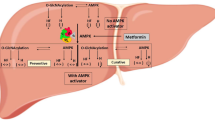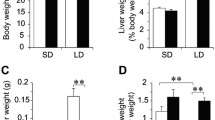Abstract
Glycosaminoglycans (GAGs) play an important role in lipoprotein metabolism. In liver, it facilitates the uptake of remnants through receptor-independent endocytosis. However, changes in liver GAGs during diet-induced hypercholesterolemia with normal levels of fat feeding are unknown. Present paper highlights the effect of diet-induced hypercholesterolemia with normal levels (5%) of fat on liver GAGs and other associated lipoprotein receptors. Hypercholesterolemia was induced in rats by feeding diet supplemented with 0.5% cholesterol and 0.125% bile salts. Hypercholesterolemia showed significantly decreased GAGs of both heparan sulfate (HS) and chondroitin sulfate/dermatan sulfate (CS/DS) classes of molecules. Quantitative real-time polymerase chain reaction analysis of GAG biosynthetic enzymes and other genes revealed significant changes in expression profile. The decrease in GAGs was prevented by simvastatin treatment; a drug that inhibits endogenous cholesterol synthesis that was used as a positive control in our study. Furthermore, there was a comparatively decreased binding of GAGs from hypercholesterolemic rats to lipoprotein lipase. LRP1 which plays a major role in lipoprotein uptake was also significantly decreased, and it was attenuated in simvastatin-treated hypercholesterolemic rats. Furthermore, LDLR and ApoE were also decreased significantly in liver of hypercholesterolemic rats. Thus, diet-induced hypercholesterolemia results in dysregulation of cholesterol homeostasis apparently through changes in GAGs in conjunction with other associated players.






Similar content being viewed by others
Abbreviations
- 2AB:
-
2-Aminobenzamide
- AIN-93G:
-
American Institute of Nutrition-93 Growth
- ApoB:
-
Apolipoprotein B
- ApoE:
-
Apolipoprotein E
- AUC:
-
Area under curve
- C4st1 :
-
Chondroitin 4 sulfotransferase 1
- CAM:
-
Cellulose acetate membrane
- CS/DS:
-
Chondroitin sulfate/dermatan sulfate
- DMMB:
-
1,9-Dimethyl methylene blue
- ECL:
-
Enhanced chemiluminescence
- Ext1 :
-
Exostosin 1
- GAGs:
-
Glycosaminoglycans
- HDL-c:
-
High-density lipoprotein cholesterol
- HL:
-
Hepatic lipase
- HRP:
-
Horseradish peroxidase
- HS:
-
Heparan sulfate
- HSPG:
-
Heparan sulfate proteoglycan
- CSPG:
-
Chondroitin sulfate proteoglycan
- LDL-c:
-
Low-density lipoprotein cholesterol
- LDLR:
-
Low-density lipoprotein receptor
- Lpl:
-
Lipoprotein lipase
- LRP1:
-
Low-density lipoprotein related protein 1
- Ndst1 :
-
N-deacetylase/N-sulfotransferase 1
- OFTT:
-
Oral fat tolerance test
- PGs:
-
Proteoglycans
- PVDF:
-
Polyvinylidene fluoride
- qRT-PCR:
-
Quantitative real-time polymerase chain reaction
- SDS-PAGE:
-
Sodium dodecyl sulfate-polyacrylamide gel electrophoresis
- TBST:
-
Tris-buffered saline Tween-20
- TG:
-
Triglyceride
- TRLs:
-
Triglyceride-rich proteins
- Ust :
-
Uronyl-2-sulfotransferase
- VLDL:
-
Very low density lipoprotein
- Xylt1 :
-
Xylosyltransferase 1
References
Armitage J (2007) The safety of statins in clinical practice. Lancet 370:1781–1790
Barter PJ, Brandrup-Wognsen G, Palmer MK, Nicholls SJ (2010) Effect of statins on HDL-C: a complex process unrelated to changes in LDL-C: analysis of the VOYAGER database. J Lipid Res 51:1546–1553
Chandrashekhar S, Esterman MA, Hoffman MA (1987) Microdetermination of proteoglycans and glycosaminoglycans in the presence of guanidine hydrochloride. Anal Biochem 161:103–108
Couchman JR, Pataki CA (2012) An introduction to proteoglycans and their localization. J Histochem Cytochem 60:885–897
Deng Y, Foley EM, Gonzales JC, Gordts PL, Li Y, Esko JD (2012) Shedding of syndecan-1 from human hepatocytes alters very low density lipoprotein clearance. Hepatology 55:277–286
Edwards IJ, Xu H, Obunike JC, Goldberg IJ, Wagner WD (1995) Differentiated macrophages synthesize a heparan sulfaye proteoglycan and an oversulfated chondroitin sulfate proteoglycan that bind lipoprotein lipase. Arterioscler Thromb Vasc Biol 15:400–409
Espirito Santo SM, Pires NM, Boesten LS, Gerritsen G, Bovenschen N, van Dijk KW, Jukema JW, Princen HM, Bensadoun A, Li WP, Herz J, Havekes LM, van Vlijmen BJ (2004) Hepatic low-density lipoprotein receptor-related protein deficiency in mice increases atherosclerosis independent of plasma cholesterol. Blood 103:3777–3782
Fletcher MJ (1968) A colorimetric method for estimating serum triglycerides. Clin Chim Acta 22:393–397
Folch J, Lees M, Sloane Stanley GH (1957) A simple method for the isolation and purification of total lipid from animal tissue. J Biol Chem 226:497–506
Foley EM, Gordts PL, Stanford KI, Gonzales JC, Lawrence R, Stoddard N, Esko JD (2013) Hepatic remnant lipoprotein clearance by heparan sulfate proteoglycans and low-density lipoprotein receptors depend on dietary conditions in mice. Arterioscler Thromb Vasc Biol 33:2065–2074
Fungwe TV, Cagen L, Wilcox HG, Heimberg M (1992) Regulation of hepatic secretion of very low density lipoprotein by dietary cholesterol. J Lipid Res 33:179–191
Gigli M, Ghisellia G, Torrib G, Naggib A, Rizzoa V (1993) A comparative study of low-density lipoprotein interaction with glycosaminoglycans. Biochim Biophys Acta Lipids Lipid Metab 1167:211–217
Kiran G, Srikanth CB, Salimath PV, Nandini CD (2015) Diet-induced hypercholesterolemia imparts structure-function changes to erythrocyte chondroitin sulfate/dermatan sulfate. J Biochem 158:217–224
Kjellen L, Bielefeld D, Hook M (1983) Reduced sulfation of liver heparan sulfate in experimentally diabetic rats. Diabetes 32:337–342
Linton MF, Hasty AH, Babaev VR, Fazio S (1998) Hepatic Apo E expression is required for remnant lipoprotein clearance in the absence of the low density lipoprotein receptor. J Clin Invest 101:1726–1736
Lowry OH, Rosebrough NJ, Farr AL, Randall RJ (1951) Protein measurement with the Folin phenol reagent. J Biol Chem 193:265–275
MacArthur JM, Bishop JR, Stanford KI, Wang L, Bensadoun A, Witztum JL, Esko JD (2007) Liver heparan sulfate proteoglycans mediate clearance of triglyceride-rich lipoproteins independently of LDL receptor family members. J Clin Invest 117:153–164
Mahley RW (1981) Cellular and molecular biology of lipoprotein metabolism in atherosclerosis. Diabetes 30:60–65
Mahley RW, Ji ZS (1999) Remnant lipoprotein metabolism: key pathways involving cell-surface heparan sulfate proteoglycans and apolipoprotein E. J Lipid Res 40:1–16
Martı’nez-Beamonte R, Navarro MA, Acin S, Guille’n N, Barranquero C, Arnal C, Surra J, Osada J (2013) Postprandial changes in high density lipoproteins in rats subjected to gavage administration of virgin olive oil. PLoS One 8:e55231
Martins IJ, Hone E, Chi C, Seydel U, Martins RN, Redgrave TG (2000) Relative roles of LDLr and LRP in the metabolism of chylomicron remnants in genetically manipulated mice. J Lipid Res 41:205–213
Mooij HL, Bernelot Moens SJ, Gordts PLSM, Stanford KI, Foley EM, van den Boogert MAW, Witjes JJ, Carlijne Hassing H, Tanck MW, van de Sande MAJ, Levels JH, Kastelein JJ, Stroes ES, Dallinga-Thie GM, Esko JD, Nieuwdorp M (2015) Ext1 heterozygosity causes a modest effect on postprandial lipid clearance in humans. J Lipid Res 56:665–673
Planer D, Metzger S, Zcharia E, Wexler ID, Vlodavsky I, Chajek-Shaul T (2011) Role of heparanase on hepatic uptake of intestinal derived lipoprotein and fatty streak formation in mice. PLoS One 6:e18370
Qu S, Perdomo G, Su D, D’Souza FM, Shachter NS, Dong HH (2007) Effects of apoA-V on HDL and VLDL metabolism in APOC3 transgenic mice. J Lipid Res 48:1476–1487
Rasband WS (1997-2016) ImageJ, U. S. National Institutes of Health, Bethesda http://imagej.nih.gov/ij/
Reeves PG, Nielsen FH, Fahey GC Jr (1993a) AIN-93 purified diets for laboratory rodents: final report of the American Institute of Nutrition ad hoc writing committee on the reformulation of the AIN-76A rodent diet. J Nutr 123:1939–1951
Scott JE (1960) Aliphatic ammonium salts in the assay of acidic polysaccharides from tissues. Methods Biochem Anal 8:145–197
Srikanth CB, Salimath PV, Nandini CD (2012) Erythrocytes express chondroitin sulfate/dermatan sulfate, which undergoes quantitative changes during diabetes and mediate erythrocyte adhesion to extracellular matrix components. Biochimie 94:1347–1355
Staprans I, Felts JM (1985) Isolation and characterization of glycosaminoglycans in human plasma. J Clin Invest 76:1984–1991
Sultan F, Cardona-Sanclemente LE, Lagrange D, Lutton C, Griglio S (1990) Lipoprotein lipase and hepatic lipase activities in a hypercholesterolemic (RICO) strain of rat. Effect of dietary cholesterol. Biochem J 266:349–353
Tasdelen I, Berger R, Kalkhoven E (2013) PPARγ regulates expression of carbohydrate sulfotransferase 11 (CHST11/C4ST1), a regulator of LPL cell surface binding. PLoS One 8:e64284
Wang YM, Zhang B, Xue Y, Li ZJ, Wang JF, Xue CH, Yanagita T (2010) The mechanism of dietary cholesterol effects on lipids metabolism in rats. Lipids Health Dis 9:4
Yamaguchi Y, Inatani M, Matsumoto Y, Ogawa J, Irie F (2010) Role of heparan sulfate in mammalian brain development current views based on the findings from Ext1 conditional knockout studies. Prog Mol Bol Transl Sci 93:133–152
Young EK, Chatterjee C, Sparks DL (2009) HDL-ApoE content regulates the displacement of hepatic lipase from cell surface proteoglycs. Am J Pathol 175:448–457
Zeng BJ, Mortimer BC, Martins IJ, Seydel U, Redgrave TG (1998) Chylomicron remnant uptake is regulated by the expression and function of heparan sulfate proteoglycan in hepatocytes. J Lipid Res 39:845–860
Zlatkis A, Zak B (1969) Study of a new cholesterol reagent. Anal Biochem 29:143–148
Acknowledgements
Kiran G acknowledges ICMR (3/1/2/25/11RHN), New Delhi, for the award of research fellowship. CSIR is acknowledged for the financial support, and Director of CSIR-CFTRI is acknowledged for his kind support and interest in this work.
Author information
Authors and Affiliations
Corresponding author
Ethics declarations
Conflict of interests
The authors declare that there is no conflict of interests.
Rights and permissions
About this article
Cite this article
Kiran, G., Prasada Rao, U.J.S., Salimath, P.V. et al. Diet-induced hypercholesterolemia alters liver glycosaminoglycans and associated-lipoprotein receptors in rats. J Physiol Biochem 73, 539–550 (2017). https://doi.org/10.1007/s13105-017-0583-z
Received:
Accepted:
Published:
Issue Date:
DOI: https://doi.org/10.1007/s13105-017-0583-z




